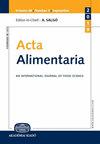Effect of nutritionally complete feed with different fatty acid profile on the fatty acid composition of common carp fillet
IF 1
4区 农林科学
Q4 FOOD SCIENCE & TECHNOLOGY
引用次数: 0
Abstract
Hungarian pond fish production is based on grains, but in the last few years, new ideas and efforts have appeared to intensify carp production technology. The basic objective was to change grain-based feeding to nutritionally complete feeds, which ensure rapid growth and more efficient feed conversion rates. This study aimed to utilise empty ponds during the summer period for carp production. Thus, there is no need for fish producers to catch fish in large ponds at the operating water level to satisfy smaller market demands appearing during the summer. The other aim was to compare the meat quality of fish raised on traditional and nutritionally complete feed until market size in the last year of production. Fatty acid profile and the levels of saturated, monounsaturated, and polyunsaturated fatty acids in fish fillets were specified, and their ratios were analysed. The result showed that nutritionally complete feed with different fatty acid composition affects the fatty acid composition of carp fillet during the rearing period. Quality of the fillet of carp fed with higher unsaturated fatty acid content became more favourable to the consumers due to health promoting effect of polyunsaturated fatty acids.不同脂肪酸组成营养完全饲料对鲤鱼鱼片脂肪酸组成的影响
匈牙利池塘鱼的生产以谷物为基础,但在过去几年中,出现了加强鲤鱼生产技术的新想法和新努力。基本目标是将以谷物为基础的饲料改为营养完全的饲料,以确保快速生长和更有效的饲料转化率。本研究旨在利用夏季的空池进行鲤鱼生产。因此,鱼类生产者不需要在作业水位的大池塘中捕捞鱼类,以满足夏季出现的较小的市场需求。另一个目的是比较在生产的最后一年以传统饲料和营养完全饲料饲养的鱼的肉质,直到市场规模。确定了鱼片中的脂肪酸分布和饱和、单不饱和和多不饱和脂肪酸的水平,并分析了它们的比例。结果表明,不同脂肪酸组成的营养完全饲料对育成期鲤鱼鱼片脂肪酸组成有影响。由于多不饱和脂肪酸的健康促进作用,不饱和脂肪酸含量越高的鲤鱼鱼片越受消费者青睐。
本文章由计算机程序翻译,如有差异,请以英文原文为准。
求助全文
约1分钟内获得全文
求助全文
来源期刊

Acta Alimentaria
农林科学-食品科技
CiteScore
1.80
自引率
0.00%
发文量
47
审稿时长
18-36 weeks
期刊介绍:
Acta Alimentaria publishes original papers and reviews on food science (physics, physical chemistry, chemistry, analysis, biology, microbiology, enzymology, engineering, instrumentation, automation and economics of foods, food production and food technology, food quality, post-harvest treatments, food safety and nutrition).
 求助内容:
求助内容: 应助结果提醒方式:
应助结果提醒方式:


